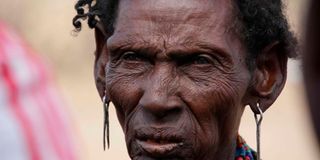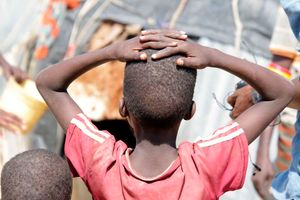Wasting away: Kenya's dreadful malnutrition crisis

Amaro Maria, 65, a resident of Illeret village in Marsabit County on April 2, 2022. Photo/ JOSEPH KANYI
What you need to know:
- When the World Bank confirmed Kenya’s status as a lower-middle income country in 2015, it opened the country for restrictions on access to international donor funds to purchase RUTFs
- Kenya lacks a government entity specifically dedicated to nutrition as it sees nutrition as something that can be merely sorted by lowering seed and fertiliser prices to increase food production
- If rains don't come, food insecurity will worsen in Marsabit County to emergency levels. Even if rains come, it will take households longer than usual to reap the benefits of a good season
The acrid smell of utensils and shreds of beddings hits our nostrils as we bend to enter a grass-thatched manyatta at Hula Hula, Marsabit County.
Here, Lariyon Taraya welcomes us and points to some wooden stools on which we sit. She fetches a cup of water for her emaciated two-year-old, second-born son. So feeble is the boy that he can be swept off by the next blow of the wind.
Lariyon tells us the last cup of porridge her son had was three days ago. A well-wisher had given her some flour to last her extended family of 17 for just a day.
Wrinkles of despair are constantly plastered on her face and even her frail voice and puny posture tell the story of a panicky hamlet that can be wiped out by drought in a few weeks’ time.
If that happens, Lariyon is afraid her babies will be the first to die of hunger.
“I have nothing in my breasts to feed my last born, who is six months old,” she tells Healthy Nation. “I have been hungry for several weeks. There is still nothing to eat.”
Outside, old men are scraping cow skins with knives in an attempt to convert them into hides after their herds died recently from the drought ravaging livelihoods in northern Kenya.
They used to have over 1,000 heads of cattle but now only 241 heads are remaining.
“We have to sell the hides of skin and see if we can get money to buy food and sorghum for our families,” said Letalel Ismail, a father of seven whose wife recently welcomed a baby boy.
He said his family used to rely on ready-to-use-therapeutic foods (RUTFs), a high-calorie, nutrient-dense peanut paste, to combat malnutrition often experienced in this community.
The substance, commonly known by the brand name Plumpy’Nut, is endorsed by the World Health Organization to treat severe acute malnutrition, the worst form of malnutrition.
Lariyon said the last time her community had access to RUTFs was in 2018. She is from just one of the many thousands of families currently experiencing food insecurity in Marsabit, one of the 23 Arid and Semi-Arid Lands (ASALs) counties in Kenya.
But why are these communities facing deeper afflictions now compared to previous drought seasons?
When the World Bank confirmed Kenya’s status as a lower-middle income country in 2015, it opened the country for restrictions on access to international donor funds to purchase RUTFs.
Both the national and county governments remain incapacitated to keep on the food donation programmes due to underinvestment in nutrition in ASAL counties.
This has left families like Lariyon’s and Ismail’s with little access to the RUTFs crucial to preventing their children from malnourishment.
In an extremely desperate move of self-intervention, Lariyon confessed to Healthy Nation that she has witnessed families giving their infants local brews and alcohol so they can sleep.
“When the babies sleep, they stop asking for food,” the 27-year-old revealed.
Halima Abdi, whose first-born baby has been sick for weeks, cannot understand why the hunger crisis in Kenya’s dry north has not been declared a national disaster.
“My baby has been bed-ridden because of the hunger we are facing. I do not know what to do and I am afraid I might lose him if the government does nothing,” she says.
Halima walked hundreds of kilometres with my baby, who is almost a year old, on her back to get medical intervention at Marsabit County Referral Hospital.
“I also wanted to see if they have RUTFs,” Abdi said. “But I was told they are out of stock. The worry and frustration keeps me awake at night.”
Last month, 11 children died of hunger in Marsabit and according to Emmanuel Atamba, an agroecologist of the The Route to Food Initiative (RTFI), hunger and starvation is on the rise in Laisamis, North Horr and Saku sub-counties.
According to Dr Bashir Issak, head of the Department of Family Health at Kenya’s Ministry of Health (MoH), child undernutrition affects health, education, and productivity in different ways. The most pressing form of malnutrition in Kenya is protein-energy malnutrition.
“Today, Kenyans are challenged to fight for the right to adequate food for all, with an estimated 3.5 million people facing a severe food security crisis,” he said.
The World Health Organisation (WHO) says Plumpy’Nut is specifically formulated for the nutritional rehabilitation of children from six months of age and adults suffering from severe acute malnutrition.
In Kenya, RUTFs have traditionally been supplied by UNICEF in partnership with the government but since 2015, food security funding shortfalls have been evident as the government struggles to finance the acquisition and distribution of plumpy nuts.
Now, due to the fact that Kenya has a devolved healthcare system where each county government is responsible for funding its own healthcare with budgetary allocations from the national government, the leadership in most of them only allocates three to four per cent of their budgets to health.
An ASAL county like Garissa allocates only two per cent according to the Kenya Parliamentary Human Rights Association (KEPHRA).
Gloria Michira, a spokesperson for the association advocating for increased budgetary allocations to food security told Healthy Nation they have petitioned 17 counties “but we have only seen budgetary increments in three counties - Kirinyaga, Busia and Nakuru.”
As per the Maputo Declaration counties are supposed to allocate at least 10 per cent of their budgets to food.
“It is time these county governments allocated more money to food security to save their people,” said Ms Michira.
Kenya lacks a government entity specifically dedicated to nutrition as it sees nutrition as something that can be merely sorted by lowering seed and fertiliser prices to increase food production.
Thus, counties prioritize infrastructure if not planting seasons instead of tackling malnutrition.
French company Nutriset supplies UNICEF with RUTFs which are distributed in Kenya. The high-calorie packets are also manufactured domestically in Nairobi, but the company said that it cannot sell its products within the country.
A top government health official who sought anonymity said the country no longer gets the full support it needs from UNICEF because according to World Bank metrics, Kenya transitioned to being a lower middle-income country eight years ago.
Dr Andrew Mulwa, director of Medical Services, Preventive and Promotional Health at the Ministry of Health, said the effectiveness of the high-calorie substance for the child who medically qualifies for the treatment is diluted when RUTFs are shared with other family members.
The challenge, he said, is that RUTFs become food for the entire family because many families have nothing to eat.
“The intended population ends up not benefitting from it as it has been shared among the whole population.”
The fact that supplying children with RUTFs does not solve the food insecurity faced by the family as a whole is best illustrated when traveling across the border in northern Uganda, where refugees sell off RUTFs to buy other necessities for survival.
In Palabek Refugee Settlement in Lamwo District, Regina Akello, a woman from South Sudan, said she sells RUTFs because she needs the cash more than she needs the malnutrition treatment.
By registering multiple times, she can accumulate a stock of the packets to sell to traders.
“Women sell them because we don’t have other ways of making money,” Regina said.
Street hawkers sell RUTFs to people who are not malnourished but eat the contents of the packets as snacks.
Abdullah Musonye*, who sells the substance in the main market in Gulu City, buys RUTFs from women in refugee camps and then resells them at a profit of USh1,000 each.
“RUTFs are highly demanded by people, especially women who buy them for their children. Even adults like them. I eat them because they are tasty, and they add energy to the body,” Abdullah said.
Uganda is classified as a low-income country by the World Bank, and UNICEF works with the country’s Ministry of Health to treat SAM with RUTFs and therapeutic milks.
In Kenya, Dr Mulwa said Kenya is still looking for international donors to partner with.
“We will do what we can — to ensure that RUTFs are only given to those who have been assessed in clinical set ups.”
According to the government’s 2021 Short Rains Assessment Report, released by the Kenya Food Security Steering Group last month, eastern Mandera, western Marsabit, and most of Turkana received amounts just 26 to 50 per cent of the average.
Localized areas in Marsabit and Turkana received only 6 to 25 per cent of normal rainfall.
While some areas in eastern and coastal Kenya received normal or above-average rainfall, the rain was two to three dekads late, with an exception of parts of Turkana, Marsabit, Wajir, Garissa, and the coastal counties where the onset was more than four dekads late. A dekad is a 10-day rainfall period.
Late rainfall resulted in fewer acres of land being cultivated, which then continued to be affected by low precipitation levels.
In Kilifi, for example, total crop production was less than 10 per cent of the average, leaving households with stocks to last one to two months, instead of the usual three to six months.
Veronica Wanjiru Kirogo, the nutrition director at the Ministry of Health, said RUTFs are reaching some of the drought-affected areas. She denied that the sachets were not available.
“Currently we do not have a low supply of RUTFs including in areas which are badly hit by drought like Illeret,” Ms Kirogo said, noting that she has also observed households sharing RUTFs.
“My team visited Illeret this week and as such this problem is more than a health problem and requires multisectoral approaches.”
Maryanne Mwanza, a consultant dietician based in Nairobi, said RUTFs are just a temporary solution to Kenya’s malnutrition crisis.
“The government can teach Kenyans in ASAL regions who are majorly pastoralists to grow their own food, which will help them access micronutrients,” Mwanza said.
She adds that the government should support their sedentary lifestyle so that they can trade and use what they earn to buy nutritious foods and stop relying on donations.
She believes people should instead rely on a diet of dried foods such as rice, beans, and other cereals that are nutritious and help reduce vitamin and nutrient deficiencies.
But making this change requires decisive actions to aid the malnourished.
“The children in this predicament risk poor and stunted growth,” Ms Mwanza said. “This will carry on from generation to generation if the government does not act soon.”
Due to conflict and insecurity, along with decreasing forage and water resources, migration across Kenya has intensified since June 2021.
Conflicts between local communities and herders over grazing grounds have also resulted in death and displacement, such as incidents in Isiolo and Wajir counties which resulted in 10 people dying and 1,300 households being displaced. Water infrastructure was also destroyed.
Pastoralists are forced to restrict watering of their herds, which also experience decreased milk production and breeding, leaving families like Ismail’s unable to meet their household nutritional needs.
If rains don't come, food insecurity will worsen in Marsabit County to emergency levels. The past three failed rainy reasons have decreased the population’s resilience, so even if rains do arrive it will take households longer than usual to reap the benefits of a good season.
Data by the 2021 National Short Rains Assessment Report 2021 shows that the number of food-insecure people needing humanitarian assistance increased from 2.1 million to 2.8 million from July to December 2021.
Projections anticipate it to grow to 3.5 million by June 2022 if the rainfall during the March to May rainy season is below average.
By February this year, malnutrition was affecting 754,906 children aged between six and 59 months and 103,286 pregnant and lactating people.
The latest data available in the Kenya Nutrition Situation Overview report released last February paints a grim picture of the country’s malnutrition situation, noting that it has deteriorated compared to an August 2021 analysis.
The number of children requiring treatment for severe acute malnutrition has risen by 15.6 per cent from 652,960 reported in August 2021.
The key drivers of increased incidence of malnutrition, it said, include worsening food insecurity with decreasing milk availability across households; high morbidity; insufficient water, poor sanitation and low essential supplies for management of acute malnutrition.
Undernutrition can manifest in several different ways including stunting, which is low height for age; and wasting, which is low weight for height. Children can also be underweight, which is low weight for age.
All of the conditions affect a child’s physical and cognitive development, and can negatively impact a child’s productivity later in life.
According to a 2020 African Union study measuring the cost of hunger in Africa that includes data from the Kenyan National Treasury and Planning Ministry, underweight and wasting results in “high risk of mortality.”
Even though the number of undernourished people has fallen globally, more than one-third of the world’s undernourished live in Africa — a total of 282 million people in 2020, according to the United Nations’ State of Food Insecurity in the World Report 2021. It found that 46 million more Africans were affected by hunger in 2020 due to the combined effects of the pandemic, conflict, and climate change.
According to the AU study, even though Kenya has made progress in reducing stunting in children, from a high of 33 per cent in 1994 to 26 per cent in 2014, the stunting rates are still higher than the global average.
The country’s 2014 statistics, the latest year for which figures are available, show that stunting affects one in every four children under five years.
This means that out of 7.22 million children under five years, nearly 1.8 million were stunted.
This work was supported by the Global Nutrition and Food Security Reporting Fellowship from the International Center for Journalists and the Eleanor Crook Foundation.





